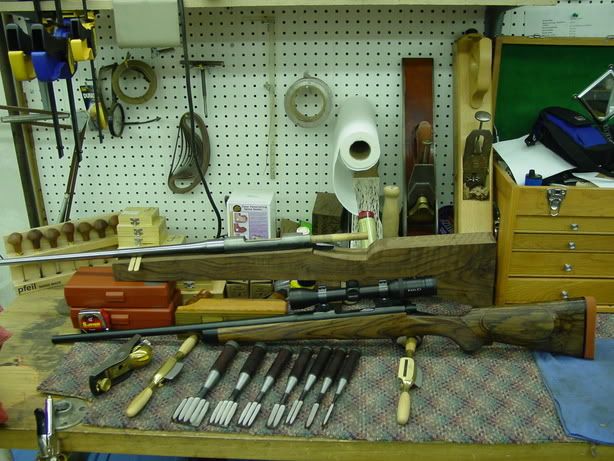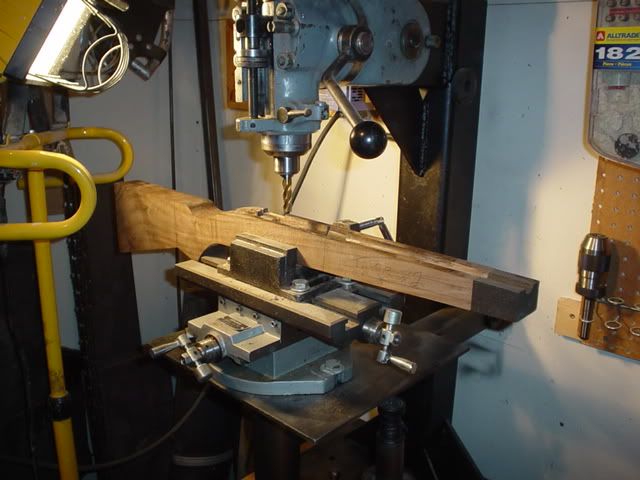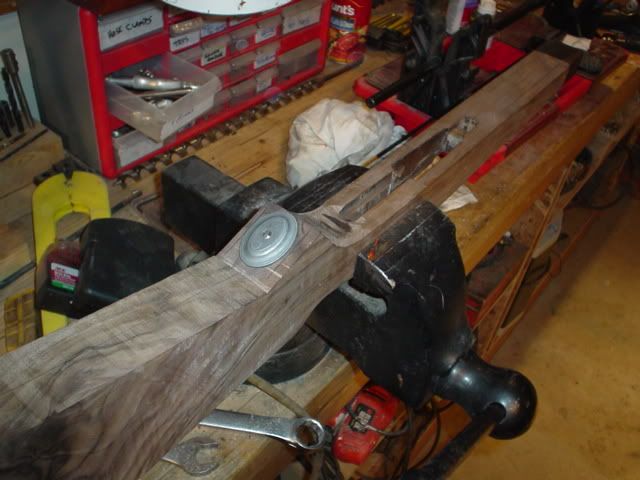

 The Accurate Reloading Forums
The Accurate Reloading Forums  THE ACCURATE RELOADING.COM FORUMS
THE ACCURATE RELOADING.COM FORUMS  Guns, Politics, Gunsmithing & Reloading
Guns, Politics, Gunsmithing & Reloading  Gunsmithing
Gunsmithing  who works from the blank
who works from the blankGo  | New  | Find  | Notify  | Tools  | Reply  |  |
| one of us |
I see a lot of folks making stocks from turned blanks, but never hear of anyone making one from the blank. I have suggested this to several people who are asking stock questions, but so far no one has tried it. I was just wondering who else here makes stocks from the blank. Even better, who else inlets to 100% wood-to-metal contact? Looks to be a dying art. | ||
|
| one of us |
My current project is my first from a blank:  I've still got a good ways to go on it. It's taking a good bit longer than if I'd started from a turned blank but I wanted to do it at least once just to see what I could learn from it. Sometimes it's as much about the Process as the Product....................DJ ....Remember that this is all supposed to be for fun!.................. | |||
|
| one of us |
Out of obstinance and poverty....   I still relieve the action area to skim glass bed, its just better. Jay Kolbe | |||
|
| one of us |
Snocat- is that a home made milling machine? If so, where did you get the idea and how do you like it? Glad to see y'all working from the blank!!! | |||
|
one of us |
I just received my first custom rifle a few months ago. He did it from the blank with full wood to metal contact. I'm very pleased with it and it inspired me to quit doing semi inlets and duplications and try one myself. I have the Wesbrook and Linden books. If there are any good videos out there I'd like to get them to. I'd kill for a mill and somebody to teach me how to use it ______________________ Always remember you're unique, just like everyone else. | |||
|
| One of Us |
Dempsey The guy you want to kill for that mill and instructions is Gunmaker. He has a mill he wants to sell that is programable and I believe he has a few programs to various stocks that go along with it. | |||
|
one of us |
I believe Mr. Hughes may start from a blank; at least sometimes anyway. Seems like I saw a picture in an article he authored a while back about custom rifles that showed him chiseling away at a blank. On the other hand, I'm not sure many gunmakers have the time to start from a blank anymore. Time is money and a good stock is awful hard to carve out quickly. Jason "Chance favors the prepared mind." | |||
|
| One of Us |
Marc, I still do it from a blank on occassion. I do it generally when I am working on a gun that I most likely will not be doing again and the pattern would just be a waste of time. It is more often a shotgun. I do inlet to 100% wood to metal fit all the time. If it does not shoot well, I will relieve the barrel channel below the top of the stock so you don't see a gap in hopes of a better group. If you are doing this for money, the objective is to get a quality stock and in the most efficient manner. If I am working on a 98 Mauser or a model 70, I have a lot of patterns and most are larger than need be so the final product will have an individual shape and I will not be turning out 20 stocks that are dimensionally the same. I don't want to do that. If it is a one off, it is often more timely to make it from the blank and shape it to the dimensions you have. | |||
|
one of us |
22wrf, it'd be a double homicide when my wife balanced the check book ______________________ Always remember you're unique, just like everyone else. | |||
|
| One of Us |
Dj the rifle in the foreground is my dream rifle. Did that one start life as a turned blank? If so who turned it? I love that Euro cheek rest with the open grip. I doubt I can get my hands on wood that good, but that is the basic set up. Have any more pics? | |||
|
| one of us |
Ed Kilgore in Goodrich, MI does most of his by starting with a blank on his duplictor. Not a "big name stocker" but nice workmanship. I'm making a "pattern" for him to use on the rifle I'm building | |||
|
| one of us |
Ive done 3 from the blank. However, when trying to make a living at it. Its just not cost effective. If I had a milling machine I would consider cutting them from the blank more often. | |||
|
| One of Us |
I have not done a pre-inlet in years. It seems most of the turned stocks have too much wood taken out where it is needed most. This is one I am currently working on, a 375 H&H on a pre-64 model 70   Jim Kobe 10841 Oxborough Ave So Bloomington MN 55437 952.884.6031 Former Professional member American Custom Gunmakers Guild | |||
|
| Moderator |
Marc, that looks like a V head from a H mill, like an add on, and put on a ?6" ? square tube. with an x/y table added... prpetty cool idea.. and those heads show up for "shipping" and some change jeffe opinions vary band of bubbas and STC hunting Club Words aren't Murder - Political assassination is MURDER Information on Ammoguide about the416AR, 458AR, 470AR, 500AR What is an AR round? Case Drawings 416-458-470AR and 500AR. 476AR, http://www.weaponsmith.com | |||
|
| One of Us |
My CNC & Bridgeport are sold. I still have my newer Victor Mill (bridgeport copy) & Hardinge mill to inlet stocks with. I enjoy stocking from a blank. It's easier to see your progress by how deep the pile of wood chips around your bench is! This one I cheated on and used my CNC to rough out the inlet, then shaped it by hand. 270 Win VZ/24 The rigby was done "old school" using a standard Bridgeport to rough the inlet. 416 Rigby GMA action& Timan metalwork These pics will be gone in a day or more. I finally have my shop moved to S Dakota. Thanks to Timan and Bill Soverns for helping unload some of my junk! I need to insulate my shop, heat it & plumb electrons all around it. Then back to making chips!!!!! gunmaker | |||
|
| one of us |
Marc- It's actually an old 3 phase M head I got for free from a Board member. I bought a VFD phase converter (awsome units) to run off household current and built the "mill" up with heavy materials I had access to. The table actually raises an lowers using a 4" industrial drill press column and collar. It is not stable enough to do fine metal milling but I can easily roughout and hand finish, it works great for wood. If I had a better x/y milling table I'd never need more for stock work. Couple hundred bucks and some MIG wire, red neck but it works well. Jay Kolbe | |||
|
| One of Us |
Jay, That is a great idea and use of a so called throwaway. | |||
|
| one of us |
And how many of you real stockmakers fit the foreend block before you start rough shaping the rest of the stock, like snowcat has done? I'm mildly surprised by these responses. For some reason, I assumed that most stockmakers that do customs for a living worked from the blank. But, since time is money, I can understand why you would rather work from a semi-inlet. Those of you doing semi-inlets, how SEMI is the inlet? Barrel channel cut? Action inletted to, say, an 1/8"? Closer? Could someone post a picture of a semi that they are just starting to finish? I have a decent Bastogne blank that I want to chisel into a stock for my .375 Taylor, because...."I want[ed] to do it at least once just to see what I could learn from it." (a GREAT quote from dj) But maybe I should have it duped to the Rimrock stock that I was going to work from anyway. I am a very average worker with my hands, and do not own a mill. How much time do you usually save by working with a semi-inlet vs the blank? MKane160 You can always make more money, you can never make more time...........LLYWD. Have you signed your donor card yet? | |||
|
| one of us |
MKane- I'm just a hobbiest but several of the truely gifted stockers that I know use pantographs to get very, very close on the inletting. Jerry Fisher, for example, glass beds each action to a pattern stock and then uses his Hoenig to get within thousandths of the final fit before picking up the scrapers. Also, making really fine pattern stocks is an art unto itself. This is a little different than buying a "semi-inlet" from Boyds and going from there. I have had a couple of stocks turned for projects and specifically requested that the smith leave more wood than even he thought was necessary on all visible surfaces allowing me to do the final fit to my standards and eliminating the possibility of gaps (that weren't my fault....) Dennis Olsen for one will do this with his Don Allen machine. Even with a turned blank there's often alot of detail work to do ie. fascets around ejector box and bottom metal, comb flutes, forend tip shaping, etc.; you've got plenty to do to finish one up well anyway. For me, it seems like 95% machine inletting saves time, exterior shaping is relatively straightforward and I would prefer to do it my self. As for the forend tip, good stockers have told me to add it after most of the inletting is done, probably better though I still do it this way most of the time. It works OK if you are careful to bring your lamp black just to the line between the tip and stock and start with the lighter colored inletting material (I use lipstick) from there... Jay Kolbe | |||
|
| one of us |
I use a duplicator mainly for economics and for customer satisfaction. I build a pattern stock and with the customer we go over the details of the stock. Any changes that need to be made can be done right on the pattern. Once the shape is refined to what the customer wants I bed the entire barreled action into the pattern. | |||
|
| One of Us |
Inormally add the tip, with the peak, before I rough out the inletting on the Bridgeport. That way I can get everything centered and do the barrel channel to the undersized dimension. I square up the blanks on three sides and all dimensions are taken off the sides and top. This really helps in keeping things straight. The first one I did from a blank was done with a mallet and chisels after squaring it up with a hand plane. What a PITA that was. Jim Kobe 10841 Oxborough Ave So Bloomington MN 55437 952.884.6031 Former Professional member American Custom Gunmakers Guild | |||
|
| one of us |
Don't know if these pictures will help or not. The bottom stock is what I would call 85-90% shaped. The basic shape is there. The top is closer to 95%. Some would just sand it and be done with it. But there is still some wood that needs to be removed.  As to inletting. The top is the 95%. I opted to have a starter channel. Most could cut you a factory contour on the barrel. Small amount of cutting and squaring up corners. The bottom needs a lot of shaping. If you are using a factory barrel and action there are several that will give you what they call a press fit.   As usual just my $.02 Paul K | |||
|
| One of Us |
I bought a bottom end stock for a Savage 110 action in a classic but simple hunter form. Has a wider forend. The wood is whatever walnut Richard's Microfit finds in California. Plain grain if any and maybe open-pored. Inletting is close enough and can be ordered more open for glass bedding. Optional channels are available. Saves a lot of time for a basic outdoor rifle which will be used somewhat like a military arm and where fit-to-body and weather resistance are desired along with a solid stock to action mating. Mine came with a buttpad. I bought a decent piece of English from a west coast supplier. Came in quarter grain form of insipid pattern but should machine well and hand work into whatever I will do with it. In my opinion I paid too much for it but I got the size and species I wanted. But I am trying to do some shotgun stocks which are going to be two piece projects. Some for pumps and some for doubles. This is self-teaching the hard way but with caution a serviceable good looking field stock should result. Proper tooling is required for these things and a lot of background experience in using odd tools. For example there is a whole Japanese chisel cutlure which is a study in itself. I noted some hollow bottom chisels in one pic above - long time since I saw those and never with that many reliefs cut into the back. Other people who use odd precision hand tools are boatbuilders. Nice thing about less complicated items like pump stocks is their smaller size so there is less overall cost if there is an error or a change in plans. If you've worked with woodworking equipment and are well conditioned from reading boat, furniture, home shop, and other disciplines' publications you are now ready to cautiously start whacking and chopping. On lesser projects start with the setup and procedures and once that's in the bag consider good wood and art in your projects. | |||
|
| one of us |
Chic- | |||
|
| one of us |
Chic- I understand about the cost of your time. I also know you are capable of making a stock from the blank, and would do it when either asked for or it made more sense. I want to get a duplicator myself one day. But i will always make some from the blank and what I turn would be patterns I made. I am glad to see that some people here are making stokcs from big squares of wood. It is totally open to letting you express yourself. I still encourage any one to try do it at least once. I remember reading an article about Hoenig a long time ago. I think it was in the mid-80's when I was in high school. He was quoted as saying that making a stock from the blank "was just about the worst way possible." I remember his exact words and understand what he was saying, but there will always be a group of people who want a stock made from a blank just for them. Kinda like my tattoos-I designed them and made the artist swear he would destroy the templates. A sort of "ink from the blank," so to speak! | |||
|
| One of Us |
Here's a blank in progress; claro on a Miroku 20 gauge, shadetree work with hand tools. Should be checkering by November.      | |||
|
| one of us |
Yeti, I like it! How did you go about inletting the action i.e. what steps did you go through? thanks.....................DJ ....Remember that this is all supposed to be for fun!.................. | |||
|
| One of Us |
Duane Wiebe still works from the blank. _________________________________ AR, where the hopeless, hysterical hypochondriacs of history become the nattering nabobs of negativisim. | |||
|
| One of Us |
Here are some updated pix on the 375 I posted earlier. It is finsh bedded and has about two soaking/filling coats of finish.   Jim Kobe 10841 Oxborough Ave So Bloomington MN 55437 952.884.6031 Former Professional member American Custom Gunmakers Guild | |||
|
| One of Us |
Jim K, It's looking good! as expected. DJ, I'm self taught so here's my steps. The buttstock's not too bad a job; just start pushing back into the action, the inletting progresses in only one direction. The drawbolt hole is kinda hairy; drill from the reciever end, and then turn it over and drill from the butt end and pray they meet up. I use a breast drill and an auger with the pilot drill ground off to avoid having the hole wander off through the stock. The forend I find to be a 3-D motherless biatch; rough in the barrel channel > push in the forend metal from the reciever side > push in the latch from the bottom > finish barrel channel > fix eff-ups. | |||
|
| Powered by Social Strata |
| Please Wait. Your request is being processed... |
|

Visit our on-line store for AR Memorabilia

